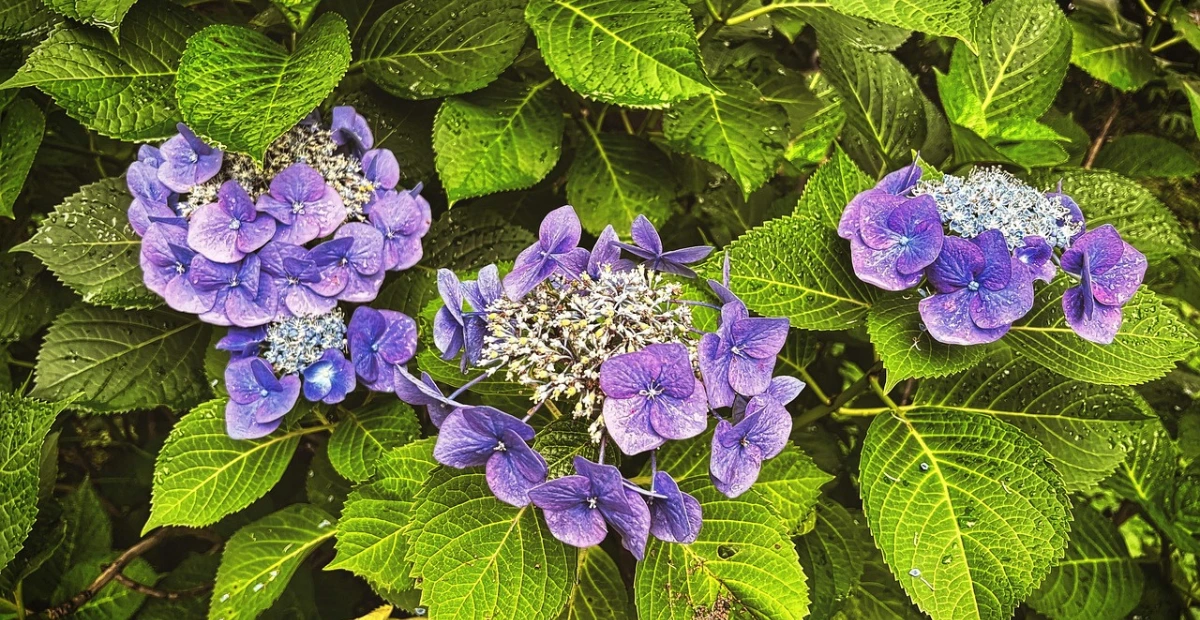Introduction: The Allure of Lacecap Hydrangeas
Imagine stepping into your garden on a warm afternoon, where the sunlight dances on delicate petals, and the soothing beauty of your flowers invites calm. Lacecap Hydrangeas are the epitome of garden elegance—each variety offering a unique twist to your landscape design. Whether you’re an experienced gardener or a beginner, Lacecap Hydrangeas can breathe life into your outdoor space, adding vibrant color and texture throughout the seasons.
advertisement
If you’re searching for the perfect hydrangea to complement your garden, you’re in the right place. Lacecap Hydrangeas are truly special due to their unique flower structure, which features inner florets surrounded by larger, showy petals. In this article, we’ll explore 5 gorgeous Lacecap Hydrangea varieties that can elevate your garden’s charm and give you tips on how to care for these stunning plants.
What is a Lacecap Hydrangea? Understanding the Basics
Before we dive into the specific varieties, let’s take a moment to understand what makes Lacecap Hydrangeas so special. Known for their distinct flower shape, Lacecap Hydrangeas have a flat-top bloom structure with smaller florets in the center, surrounded by larger, more colorful petals. This unique flower head creates an intricate, lace-like appearance, which is where the name “Lacecap” comes from.
Unlike Mophead Hydrangeas, which have full, round flower heads, Lacecap Hydrangeas offer a more refined, airy look. They are typically smaller and have a more delicate appearance, making them perfect for adding a touch of elegance to any garden.
Key Features of Lacecap Hydrangeas:
- Flower Structure: Flat-topped blooms with small inner florets and larger, showy petals around the edges.
- Size: Compact, making them ideal for borders or containers.
- Growth Habit: Can grow between 3 to 5 feet tall and wide, depending on the variety.
- Bloom Time: Typically bloom from late spring to early summer, with some varieties continuing into fall.
- Hardiness: Most Lacecap Hydrangeas thrive in USDA Zones 5-9.
advertisement
If you’re looking for a hydrangea that combines elegance and simplicity, Lacecap Hydrangeas are a fantastic choice for your garden.
5 Gorgeous Lacecap Hydrangea Varieties You Should Know
Now that you understand the basics of Lacecap Hydrangeas, let’s explore five stunning varieties that will brighten your garden and provide a gorgeous backdrop for your outdoor living space.
1. Hydrangea macrophylla ‘Blue Wave’
Hydrangea macrophylla ‘Blue Wave’ is a standout variety that will captivate you with its rich blue blooms. This variety thrives in slightly acidic soil, making it perfect for gardeners who love vibrant, blue flowers.
- Flower Color: Deep blue, with a delicate lace-like structure.
- Best for: Gardens with cooler climates or those looking to create a serene, tranquil atmosphere.
- Care Tips: For the best blue color, keep the soil slightly acidic. If you want to change the color to pink, you can raise the pH with lime.
- Planting Advice: ‘Blue Wave’ thrives in partial shade but can tolerate some sunlight. Avoid full sun exposure, as it may cause the blooms to fade prematurely.
This variety is known for its robust flowering, even in slightly cooler temperatures, making it a great option for gardeners in northern climates.
2. Hydrangea macrophylla ‘Pink Elf’
If you’re looking for a compact variety with delicate pink blooms, Hydrangea macrophylla ‘Pink Elf’ is a perfect choice. This variety is smaller in stature but equally stunning in its appearance.
advertisement
- Flower Color: Soft pink flowers with a clean, elegant look.
- Best for: Small gardens or containers.
- Care Tips: Prefers slightly acidic to neutral soil. Regular watering and proper drainage are essential to keep this variety happy.
- Planting Advice: This hydrangea is perfect for creating borders or planting along walkways. Its compact size makes it an ideal choice for containers as well.
‘Pink Elf’ brings a charming, refined look to your garden without overwhelming the space, making it perfect for minimalist garden designs.
3. Hydrangea macrophylla ‘Lady in Red’
Hydrangea macrophylla ‘Lady in Red’ is a bold and dramatic variety, known for its striking red and purple blooms. This variety stands out with its vibrant color contrast and is perfect for adding a splash of excitement to your garden.
- Flower Color: Rich red to purple hues, transitioning as the plant matures.
- Best for: Bold garden designs and striking contrasts.
- Care Tips: Prune lightly after blooming to avoid cutting off the buds for the next year. Keep well-watered, but ensure the soil drains well.
- Planting Advice: This hydrangea prefers full sun to partial shade for optimal blooming. Avoid planting it in overly damp or soggy soil.
‘Lady in Red’ creates a dramatic focal point in any garden, especially when planted against a contrasting background of green foliage.
4. Hydrangea macrophylla ‘Miss Saori’
Hydrangea macrophylla ‘Miss Saori’ is a breathtaking variety that has earned recognition for its award-winning appearance. The flowers transition from soft pink to white with splashes of cream and lavender, making it a standout in any garden.
advertisement
- Flower Color: A blend of pink, white, and lavender, with color transitions throughout the season.
- Best for: Japanese garden themes or floral arrangements.
- Care Tips: Keep the soil consistently moist but well-drained. This variety benefits from regular deadheading to maintain its appearance.
- Planting Advice: ‘Miss Saori’ thrives in partial shade and well-drained, acidic soil. It’s perfect for areas with afternoon shade.
This hydrangea adds a touch of romance and elegance to any garden and is an ideal choice if you’re looking for something truly unique.
5. Hydrangea macrophylla ‘Twist-n-Shout’
For those who want versatility with a pop of color, Hydrangea macrophylla ‘Twist-n-Shout’ offers just that. This variety features flowers that change color based on the soil’s pH level and can bloom in both blue and pink hues.
- Flower Color: Blue and pink, changing depending on the soil’s pH level.
- Best for: Versatile gardens and floral designs.
- Care Tips: Deadhead regularly to keep the plant in shape and encourage more blooms. Be mindful of soil pH to achieve your desired flower color.
- Planting Advice: Plant in moist, well-drained soil with partial sun exposure.
‘Twist-n-Shout’ is known for its adaptability, making it a great option if you enjoy experimenting with different garden designs.
How to Care for Your Lacecap Hydrangea
Proper care is essential to ensure your Lacecap Hydrangeas thrive and bloom year after year. Below are some key care tips to keep your hydrangeas looking their best.
advertisement
Key Care Tips:
- Watering: Hydrangeas need regular watering, but they don’t like sitting in water. Make sure the soil drains well to prevent root rot. Water your plants deeply, especially during dry spells.
- Soil: Lacecap Hydrangeas prefer slightly acidic to neutral soil. If you want to change the color of your blooms, you can adjust the soil’s pH. Acidic soil will give you blue flowers, while alkaline soil will turn them pink.
- Sunlight: While Lacecap Hydrangeas can tolerate some sunlight, they generally prefer partial shade. Too much direct sun can scorch the leaves and cause the blooms to fade early.
- Fertilizing: Apply a balanced, slow-release fertilizer in the spring to give your hydrangeas a good start for the growing season. Avoid over-fertilizing, as this can result in more foliage growth than blooms.
- Pruning: Prune your hydrangeas after they bloom, typically in late summer or early fall. Pruning in spring can cut off the buds for the next year, so be mindful of when you trim your plants.
Ideal Growing Conditions for Lacecap Hydrangea
For your Lacecap Hydrangea to thrive, it’s important to provide the right growing conditions. Lacecap Hydrangeas do best in environments that mimic their natural habitat—wooded areas with dappled sunlight and slightly acidic, moist soil.
Best Growing Conditions:
- Sunlight: Partial shade is ideal, though they can tolerate some direct sunlight with proper care. Too much sun can cause stress, especially in hotter climates.
- Soil: Slightly acidic soil (pH 5.5-6.5) is best for Lacecap Hydrangeas. If your soil is too alkaline, you can amend it with sulfur to lower the pH.
- Temperature: Lacecap Hydrangeas are hardy in USDA Zones 5-9. In cooler climates, you may want to mulch the base of the plant to protect it from winter temperatures.
- Watering: Consistent moisture is key. Water your hydrangeas deeply, but ensure the soil drains well to prevent root rot.
advertisement
Common Problems and Solutions with Lacecap Hydrangeas
While Lacecap Hydrangeas are relatively low-maintenance, they can experience some common problems. Below are a few issues and how to solve them.
Common Problems:
- Yellowing Leaves: This is often a sign of nutrient deficiency or improper soil pH. Test your soil and amend it with compost or organic matter.
- Lack of Blooms: Lacecap Hydrangeas may not bloom if they’re pruned too early or receive too much shade. Ensure you prune after blooming and provide enough sunlight.
- Pests: Aphids, spider mites, and scale insects can sometimes infest Lacecap Hydrangeas. Use organic insecticides or a soapy water solution to keep these pests under control.
Frequently Asked Questions About Lacecap Hydrangeas
Q 1: What makes Lacecap Hydrangea different from other hydrangeas?
Lacecap Hydrangeas differ from other types like Mophead Hydrangeas because of their unique flower structure. They have flat, lace-like blooms with smaller florets in the center, surrounded by larger, more colorful petals.
Q 2: How do I change the color of my Lacecap Hydrangea?
The color of Lacecap Hydrangeas can be altered by adjusting the pH level of the soil. For blue blooms, keep the soil acidic; for pink blooms, make the soil more alkaline.
Q 3: Can Lacecap Hydrangeas grow in full sun?
While Lacecap Hydrangeas can tolerate some sun, they prefer partial shade. Too much direct sunlight can cause the blooms to fade and the leaves to scorch.
Q 4: When is the best time to prune Lacecap Hydrangea?
The best time to prune your Lacecap Hydrangea is after it finishes blooming, typically in late summer or early fall. Avoid pruning in early spring, as you might cut off next year’s buds.
advertisement
Conclusion: Transform Your Garden with Lacecap Hydrangeas
Lacecap Hydrangeas are more than just beautiful plants—they are an investment in your garden’s beauty and tranquility. With their unique flower structures, variety of colors, and relatively easy care, they’re perfect for adding charm and sophistication to your outdoor space.
Now that you know about the 5 gorgeous varieties of Lacecap Hydrangeas, it’s time to choose the one that will elevate your garden to the next level. Whether you go for the striking ‘Lady in Red’ or the delicate ‘Pink Elf,’ you can’t go wrong. Happy gardening, and don’t forget to share your Lacecap Hydrangea journey with fellow garden enthusiasts!
Call-to-Action:
Ready to get started? Explore your options and plant your own Lacecap Hydrangea today. Whether you’re enhancing a flower bed or creating a show-stopping garden centerpiece, these beautiful plants are sure to impress. Let us know which variety you choose and how it transforms your garden!


